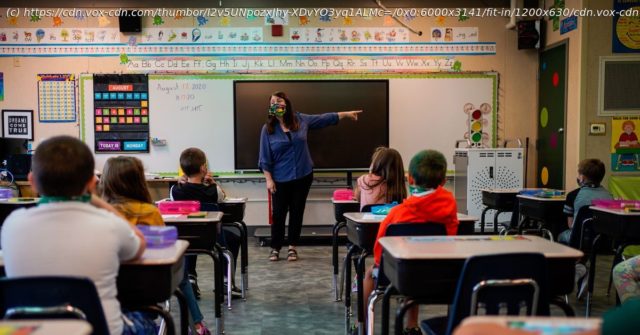Schools across America have opened their doors. Here’s how it’s going so far.
America’s largest school district, New York City, brought some 300,000 students back for in-person learning on Tuesday, even as Covid-19 rates in the city began to tick up. Meanwhile, schools in Miami announced a return to fully in-person learning this month, after a disastrous rollout of online education earlier in the fall. Then there are schools from Kentucky to New Jersey that have switched from in-person to remote learning in recent weeks due to Covid-19 cases. Like everything about the response to the coronavirus in America, school reopenings have been a patchwork, with states and districts each following their own guidelines — some informed by public health guidance, some less so. As millions of Americans try to make decisions about their children’s education, or their own work as teachers or school staff, they face a terrifying lack of information: There’s no nationwide data on the number of Covid-19 cases in K-12 schools. Still, we are starting to get a picture — or perhaps a rough sketch — of what education looks like in this time — helped along largely by data collection efforts by the New York Times and the Covid-19 School Response Dashboard. We are beginning to have a sense of how common Covid-19 is in schools that have reopened, and what schools are doing to reduce the spread of the virus. We know that rates among staff are markedly higher than those among students — not a surprise given previous evidence that adults are more likely to contract the virus, but significant nonetheless. And we know that, at least for now, hybrid learning models employed in many districts to make schools safer have not completely eliminated the risk. With schools having just started in some places — and concerning signs of a new surge as summer moves to fall — the coming weeks may bring answers to some of the biggest questions about Covid-19 and schools. One key indicator will be whether the overall rate of cases in schools increases from week to week, Emily Oster, an economics professor at Brown University who co-created the dashboard, told Vox: “If they’re 0.75 percent this week, are they 3 percent next week, and 6 percent the week after that? That would be very worrisome.” And while we don’t yet have much of a longitudinal view, the 10 facts below offer a guide to what we know so far — and what we need to find out.1) Almost half of American schools planned to start the year fully in-person Part of the difficulty in fully understanding Covid-19 risk in schools is that approaches to pandemic education are incredibly varied. While some states, like California, have issued guidelines barring districts from opening if transmission is too high — and others, like Florida, have pressured schools to open regardless of transmission — decisions have often been left up to individual districts themselves. Efforts to map reopening around the country end up looking like patchwork quilts. Still, we have some nationwide data about reopening plans at the beginning of the school year. In a nationally representative survey of 477 districts conducted in late August by the Center on Reinventing Public Education (CRPE),49 percent planned to open fully in-person. Meanwhile,26 percent planned to be fully remote, and 12 percent planned to open on a hybrid model, with students in-person on some days and remote on others. And 85 percent of districts planned to offer some fully remote option for families, even if they also offered in-person instruction.2) Those serving a high percentage of students in poverty are more likely to be fully remote Around the country, district reopening plans vary widely based on population density, the CRPE survey found. Rural districts were most likely to plan a fully in-person start, with 65 percent indicating such a plan compared with 24 percent of suburban districts and 9 percent of urban ones. And nearly four out of five urban districts planned to start the year fully remote. Districts with a high percentage of students living in poverty were also more likely than others to plan for a remote start. Just 24 percent of districts with the lowest rate of poverty in the CRPE survey planned to start remotely, compared with 41 percent of the highest-poverty districts. In some cases, this may have to do with virus risk, as communities with high levels of poverty have also been disproportionately affected by the coronavirus. It’s also possible that the expense of hybrid learning, which requires complex scheduling and potentially more staff, may be prohibitive for high-poverty districts — as the CRPE report notes, “high-poverty districts were much less likely to plan for logistically complex and likely more expensive hybrid learning.” The divide between high- and low-poverty districts is concerning, the report notes, because students in poverty face disproportionate barriers to successful remote learning, from a lack of adequate space at home for schoolwork to parents who need to work outside the home and can’t supervise their children’s schooling. Schools around the country are going above and beyond to help students in poverty with remote learning, but so far, many lack the help they need from states and the federal government. “It’s a absolute tragedy that our communities that are getting hit most by the pandemic are then getting hit once again by the effects of schools being closed,” Brandon Guthrie, a professor of global health and epidemiology at the University of Washington, told Vox.3) Schools and districts are changing their plans constantly The CRPE report paints a picture of what districts were planning at the beginning of the school year. But schools are changing their plans constantly in the face of changing viral conditions and, sometimes, political pressures. For example, when EdWeek surveyed districts in July, about 13 percent planned for all-remote learning. When the publication conducted the survey again at the end of August, that figure jumped to around 23 percent. But some districts shifted in the opposite direction — 9 percent told EdWeek in July that they would be fully in-person, while 13 percent said so by the end of August. Sometimes, these changes are a response to rising or falling case counts in the community. A school district in Mifflinburg, Pennsylvania, for example, decided to reopen for full in-person learning after planning for a hybrid model for some students, because cases in the county declined, according to EdWeek. Other districts, such as one in State College, Pennsylvania, have shifted to a fully remote schedule as case counts in the area increase. In other cases, however, districts have been forced to change plans after orders from the state.






